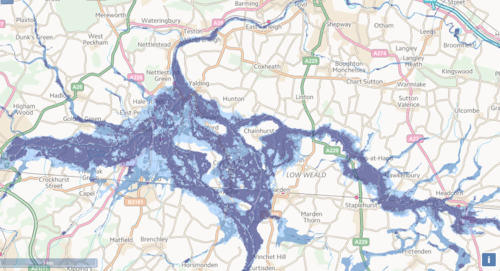Pilot description
Area description
Size of the pilot area: 1,386km2 (Environment Agency, 2017), but within this area our main focus was on the priority sub-catchments of the Alder Stream (8 km2 km) and School Stream (9 km2 ) along with a number of demonstration projects and trials on other sites.
Number of inhabitants: The total population of project area was in the region of 370,000 in 2018. The population of the priority sub-catchments which are the focus of this project is much smaller, in the region of 10,000.
Relevant characteristics of the water system: Rivers present in this catchment are the Medway, Beult, Teise, Bourne and Eden, as well as their tributaries. Kent has a diverse and expanding economy thanks to its proximity to London and strategic location with good transport links to mainland Europe. The rural economy is diverse ranging from intensive agriculture in the Low Weald to traditionally managed deciduous woodland in the High Weald. It has long been noted for a diverse range of horticultural activity such as fruit and hop growing, and is known as ‘The Garden of England’. Land ownership areas tend to be small in area, and diverse in type and economic interest of owner. There are many landowners whose principle income is from other sources than the rural economy.
Flood risks
Risks: Fluvial and pluvial flooding exacerbated by landcover change which has reduced surface roughness, rapid run-off from impervious clay soils on the high ground, and from steepter slopes, onto the lower lying land of the Low Weald. There is also the lesser-known risk of groundwater flooding dues to the presence of springs in areas such as Tunbridge Wells (JBA Consulting, 2019)
Probability: Major flooding events have occurred on a number of occasions in recent history and have attracted national attention, such as the flooding in Yalding in 2013/14. Smaller communities such as Headcorn suffer much more frequent flood events, on a scale of one to five years or so.
Impacts: The catchment has suffered significant flooding in 1968, 2000/01 and more recently in 2013/14 leading flood organizations work together with communities to improve flood resilience. Generally, a total of 9000 properties (2.246 homes and businesses) are at risk in the Medway catchment (Environment Agency, 2017). After the flood in 2013/14 the Medway Flood Partnership was created which involves a broad range of stakeholders and authorities at different levels (Environment Agency, 2017). The total annual average damages in the Medway catchment was in the region of £431,000 in 2017 (Environment Agency, 2017).
Tigure 1: Areas at risk of flooding from rivers in the Medway catchment.

